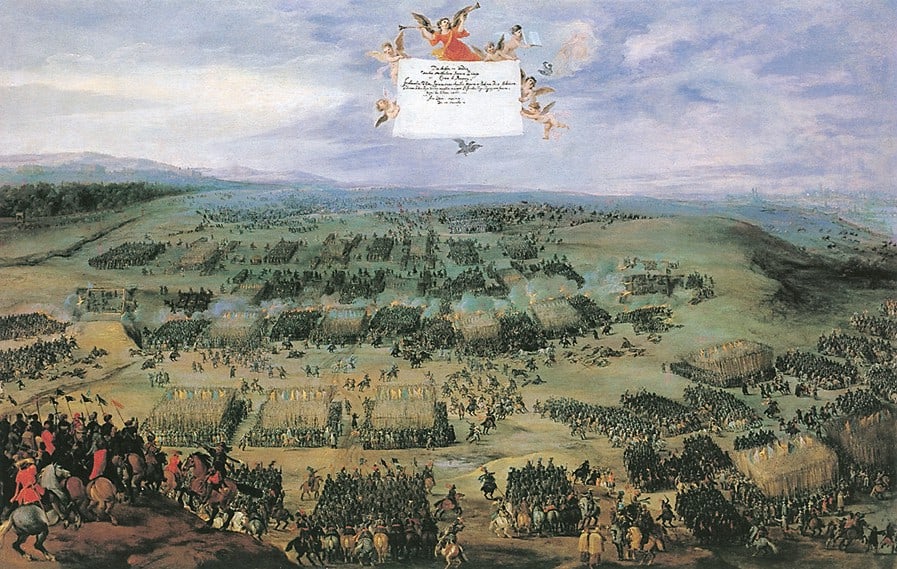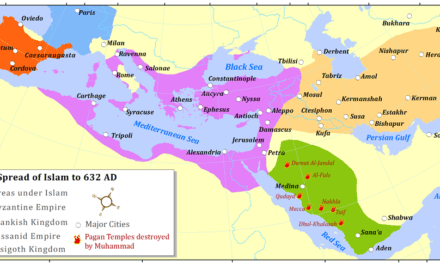This episode is titled, “Wars of Religion”
In our review of the Reformation, we began with a look at its roots and the long cry for reform heard in the Roman church. We saw its genesis in Germany with Martin Luther and Philip Melanchthon, its impact on Switzerland with Zwingli and later with the Frenchman John Calvin. John Knox carried it to his native Scotland and Thomas Cranmer led it in England.
We’ve taken a look at the Roman Catholic response in what’s called the Counter-Reformation, but probably ought to be labelled the Catholic Reformation. We briefly considered the Council of Trent where the Roman Church affirmed its perspective on many of the issues raised by Protestants and for the first time, a clear line was drawn, marking the differences in doctrine between the two groups. We saw the Jesuits, the learned shock-troops of the Roman Church sent out on both mission and to counter the impact of the Reformation in the regions of Europe being swung toward the Protestant camp.
Let’s talk a little more about the Catholic Counter-Reformation because Europe is about to plunge into several decades of war due to the differing religious affiliations of its various kingdoms.
There were at least four ingredients in the Counter-Reformation.
The first concerned the religious orders of the Catholic Church. There was a spiritual renewal within older orders like the Franciscans, Dominicans, and Benedictines. Reform among the Franciscans led to the founding of the Capuchins in 1528. Their energetic work among the Italian peasantry kept them loyal to Rome.
Second, new orders sprang up. Groups like the Theatines [Thee a teen] who called both clergy and laity to a godly lifestyle. The Ursulines [Ursa-leens] were an order for women who cared for the sick and poor. And then of course, there were the Jesuits.
The Society of Jesus, or Jesuits, were the most important of the new orders. Founded in Paris in 1534 by Ignatius of Loyola, the order required total obedience of its members for the furtherance of the interests of the Roman church. While there were good and godly Jesuits, men who worked tirelessly to expand the Kingdom of God, there were also some whose motives were less noble. Okay, let’s be frank; they were diabolical. Utterly unscrupulous in their methods, they believed it was permissible to do evil if good came of it. They resurrected the Inquisition in the 16th C making it an effective tool in stomping out the Reformation in Italy, Spain, Portugal, and Belgium.
Jesuits infiltrated government offices and used every means fair or foul to advance the cause of the Rome. Lest Catholic listeners take offense to this, understand that their power became so great and their methods so immoral, the Pope suppressed the order from 1773 to 1814.
Also, it should be noted when Ignatius launched the Society, a counterattack on the Reformation was not in view. His ambition was missionary with a keen desire to convert Muslims. The three major goals of the Jesuits were to convert pagans, combat heresy, and promote education. It was their solemn oath to obey the Pope that led to their being used as a tool of the Counter-Reformation.
A third aspect of the Counter-Reformation was the Council of Trent. The cardinals elected a Dutch theologian as a reform pope in 1522. He admitted that the problems Rome had with the Lutherans came because of the corruption of the Church, from the papal office down. As was saw a couple episodes ago, in 1536, Pope Paul III appointed a special panel of cardinals to prepare a report on the condition of the Church. That report gave Luther much ammunition for his critique of Rome. It conceded that Protestantism resulted from the “ambition, avarice, and cupidity” of Catholic bishops.
The Roman Church realized it needed to address the issues raised by the Reformers. The Council of Trent was the answer. It met in three main sessions, under the terms of three different popes, from 1545 to 63. Participants came from Italy, Spain, France, and Germany. The Council decided a wide array of issues.
In direct response to Lutheran challenges, the Council abolished indulgence-sellers, defined obligations of the clergy, regulated the use of relics, and ordered the restructuring of bishops.
The doctrinal work of Trent is summarized in the Tridentine Profession of Faith, which championed Roman Catholic dogma and provided a theological response to Protestants. Trent rejected justification by faith alone and promoted the necessity of meritorious works as necessary for salvation. It validated the seven sacraments as bestowing merit on believers and their necessity for salvation. It affirmed the value of tradition as a basis of authority alongside the Bible. It approved the canonicity of the apocryphal books of the Old Testament; made official the existence of purgatory; the value of images, relics, indulgences, the invocation of saints; and the importance of confession to a priest. It also defined more specifically the sacrificial aspects of the mass and decided that only the bread should be distributed to the laity.
The Tridentine statement made reconciliation with Protestantism impossible.
The Council’s work constituted a statement of faith by which true Roman Catholics could determine their orthodoxy. No such comprehensive statement existed before. If it had, perhaps the force of the Reformation would have been blunted in some places. What the Council of Trent did, in effect, was to make official dogmas of the Church the various positions Luther had challenged in his break with Rome.
A fourth aspect of the Counter-Reformation was a new and vigorous kind of spirituality that bloomed in a remarkable series of writings and movements. Some devotional books from this movement, such as the Imitation of Christ by Thomas a’Kempis and the Spiritual Exercises by Loyola, have received proper attention, but most of have not.
This new kind of devout life was characterized by a systemic examination of conscience, prayer, contemplation, and spiritual direction. Its roots lay in the Middle Ages with groups like the Carthusians, who put great emphasis on the contemplative life. It was these works that fueled the calls for reform in the Roman Church before Luther arrived on the scene. They were the reading material of groups like the Brethren of the Common Life and The Oratory of Divine Love which provided many of the best church leaders in the years leading up to the 16th C.
The Reformation sparked a series of religious wars across Europe. The last of these was the Thirty Years’ War, which last from 1618–48.
As we saw in a previous episode, the Peace of Augsburg in 1555 put Lutheranism on a legal basis with Roman Catholicism in Germany. The prince of a region determined the religion in his territory; dissenters could immigrate to another territory if they wanted to.
Now, that may seem obvious to highly mobile moderns like many listening to this, but it wasn’t for people at that time. Due to feudal rules, people weren’t allowed to move without consent of their ruler. The Peace of Augsburg marked a significant change in commoners’ mobility. To preserve Catholic domination of southern Germany, the agreement mandated that Catholic rulers who became Lutherans had to surrender rule. The agreement left out Calvinists, Anabaptists, and other Protestants. So for many, Augsburg solved nothing.
Beginning in Bohemia, the Thirty Years’ War ravaged Central Europe and Germany and involved all the major European powers. The Peace of Westphalia, which ended the war in 1648, resulted from long and complicated negotiations. France and Sweden gained large amounts of territory, and German princes gained greater power and influence at the expense of the Emperor. The treaty finally recognized Calvinism, along with Lutheranism and Catholicism, as legal religions and permitted each ruler to determine the religion of his state.
The effects of the War were devastating for Christianity as a whole. Religious issues were increasingly treated with indifference by political leaders. Secular, self-serving matters were now the chief concerns of the growing uber-worldly nation-states. The barbarity and brutality of the war left many questioning the Christian Message. How could a Faith that produced such atrocities be true? Doctrine took a backseat to doubt. Faith was met with skepticism. All this coming at the dawn of, and no doubt hastening, The Age of Reason.
In reply to those who criticize Christianity for the wars fought at that time, it ought to be recognized that in every case; political, economic, and social considerations were as important as the religious, if not more. Much of the time, there was no real struggle between Roman Catholics and Protestants. And on some fronts of the war, BOTH Catholics and Protestants fought alongside each other as comrades because their conflict was political rather than religious. We call this period the “Wars of Religion,” but in truth it was rarely religion that sparked or drove the conflict; it was political and economic, hiding behind a mask of religion because that tends to stir the people actually doing the fighting better than some prince wanting more land.
Nine times out of ten, if you want to know the real cause of something, follow the money.
We turn now to the impact of the Reformation on France and one example of how tragic things can turn – ostensibly, because of religion, but really because of politics.
As the 16th C wore on, the Roman church in France fell into a progressively deplorable condition. The Concordat of Bologna in 1516 gave King Francis I the right to appoint the ten archbishops, thirty-eight bishops, and 527 heads of religious houses in France. That meant the Church became part of a vast patronage system, and individuals won positions in the Church not for ability or religious zeal but for service to the crown. Simony & bribery was de-rigor.
Conditions became genuinely bad. Literacy among priests dropped to a mere ten-percent. Since the king was head of the French Church, and he depended on its patronage system for income, we see why Francis I and Henry II were so zealous in their persecution of French Protestants. They couldn’t afford to permit the system to crumble. They certainly weren’t zealous for Catholicism except as a tool to achieve their political ambitions.
The French Protestant movement was stoked by what was happening in Geneva in Switzerland under Farel and Calvin. The French Bible, Calvin’s Institutes, and numerous other Protestant publications fueled the movement. So naturally, the most literate element of the population was won over. Converts were numerous at the universities and among lawyers and other professionals, the merchant class and artisans, lower clergy, friars, and the lesser nobility. The illiterate peasantry was hardly touched and remained firmly Catholic.
Politics and economics played into the mix. The Middle-class and lower nobility of France were tired of King Francis’ imperial ambitions, funded on their backs. They were urged into the Protestant cause out of a desire to get rid of the King. It’s estimated that two-fifths of all nobles joined the French Protestant cause. Few of them were authentically converted but sought to use the Protestant movement to weaken the trend toward King Francis’ oppressive version of royal absolutism.
In spite of persecution, Protestants increased rapidly. At the beginning of the reign of Henry II in 1547 they numbered over 400,000. By the end of his reign in 1561 they were known as Huguenots and numbered 2 million; ten-percent of the population. The Presbyterian system of church government gave organization and discipline to the Huguenot movement.
In order to understand the course of events the French Reformation took and see why it became embroiled in civil war, it’s necessary to look at the political and social conditions of the times.
First, that many of the younger nobility joined Protestant ranks is of great significance. Accustomed to carrying swords, they became protectors of Huguenot congregations during troubled times. They often protected church meetings against hostile bands of Catholic ruffians.
Second, and this is key; there were four major groups of nobility vying for the rule in France.
The ruling house with a tenuous grip on the throne was the Valois.
The Bourbons of Western France were next in line should the Valois falter. Their leadership were decided Huguenots.
The powerful Guises [Guy-zuhz], were equally committed Roman Catholics with extensive holdings in the East.
The Montmorencys controlled the center of France; their leadership divided evenly between Huguenots and Catholics.
Third, when Henry II died, he left three sons all dominated by his queen, Catherine de Medici. She was determined to maintain personal control and advance the power of her government. She was opposed by many of the nobility jealous of their rights and wanted to restrict the power of the monarchy.
Fourth, as the likelihood of civil war in France percolated, the English and Spanish sent aid to their factions to serve their respective interests.
Such animosities provided the tinder to ignite armed conflict. Eight wars were fought between Roman Catholics and Protestants in France. Leading the Protestants early in the conflict was Gaspard de Coligny. But he lost his life along with some 15 to 20,000 Huguenots in the massacre of St. Bartholomew’s Day, in August, 1572. After that, Henry of Navarre, of the Bourbon family, led the Protestants. His maneuvers were successful, and eventually, with the death of others in the royal line, he became heir to the French throne. Because he didn’t have enough strength to complete his conquest, he converted to Catholicism and won the crown as Henry IV. Judging from his conduct, Henry’s religious principles sat his shoulders rather lightly. His switch to the Roman Church was for purely political reasons. Most likely he simply sought to turn off the blood bath drenching France.
In 1598, Henry published the Edict of Nantes, a grant of toleration for the Huguenots. It guaranteed them the right to hold public office, freedom of worship in most areas of France, the privilege of educating their children in other than Roman Catholic schools, and free access to universities and hospitals. The edict was the first significant recognition of the rights of a religious minority in an otherwise intolerant age. Though the Huguenots enjoyed a period of great prosperity after that, King Louis XIV revoked the edict in 1685. Thousands were driven into exile, to the benefit of England, Holland, Prussia, and America where they fled for refuge.





Now I understand why when we used to attend mass on saturday mornings only wafers were offered and not wine. Thanks Pastor Lance.